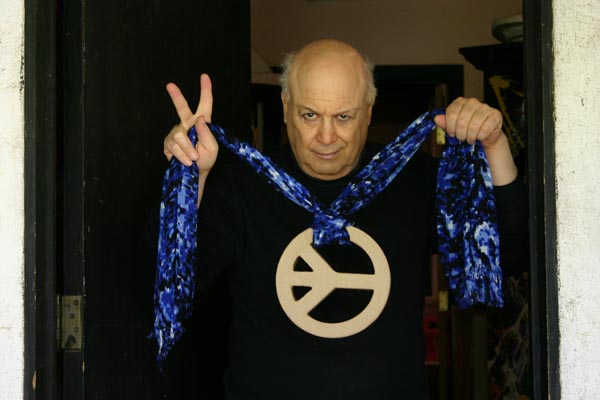I engineered a few sessions with Ornette acting as Producer . He was working with a female Japanese singer who's name escapes me at the moment, at Laswell's Greenpoint studio. I don't recall the other musicians except that Jamaaladeen Tacuma was playing bass. Also don't know if anything got released from these sessions. Coleman didn't seem particularly focused or even comfortable in the role of Producer at that time, more understated and abstract. Sometimes I felt we were drifting in space with little or no discernible direction. I remember once the drummer playing a basic 4/4 beat and Ornette asking him what it would sound like if he was to reverse the beat, play the bass drum where he was hitting the snare and vice versa.
It wasn't until Bill Laswell produced a record for artist, now director, Julian Schnabel, that an opportunity arose to record Ornette playing his horn. Schnabel had approached Bill asking for help in getting his songs recorded. Bill put together a top notch backing band that included himself on bass, one of my favorite drummers, Anton Fier of Golden Palominos fame, on drums, Nicky Skopelitis on guitars, and Bernie Worrell on keys. The usual suspects, as it were.
There's a few stories to tell about the making of this one which I'll get to in their time. Ornette comes in when the album was nearly done. Most of the songs had been mixed but there were still a couple that had spots that could have used a solo and/or embellishments of some kind on the whole track. Bill suggested to Schnabel, "Why don't we ask Ornette to play?"
That began a whole process and somewhat of a drama. Apparently Ornette didn't say yes or no when asked but agreed to consider it. One morning as we were getting underway, Bill mentioned that Ornette had agreed to come down to the studio to meet. The songs had been tracked at Greenpoint, but at this point we were at Campeau Studio on West 3rd Street just east of Broadway to mix on their SSL.
So it was arranged for Ornette to come down to Campeau one evening to meet Schnabel and get to know the music. He arrived before Julian, I saw him waiting in the lounge seated on the black leather couch with Bill, and Michael Lang who was helping Julian in some music management capacity.
Michael Lang was one of the organizer's of the Woodstock festival. If you've ever seen the film, he's the brash young kid with a head full of long brown frizzy hair riding about on a motorcycle. He had mellowed considerably since that time but was still a formidable, if quiet, presence in the room.
I was in and out of the lounge setting up for the evening's playback session and couldn't help but overhear Ornette discussing a peyote ritual he had participated in. I remember him giving the opinion that he considered psychedelic plants to be essential nutrients for the soul in the same way that vitamins are for the body and brain.
When Schnabel arrived, we moved into the control room to play Ornette the songs that had already been mixed. Bill stayed in the lounge but we left the intercom open so he could hear the conversation. So it was myself, Ornette Coleman, Julian Schnabel and Michael Lang in the control room for the playback session.
Ornette was extremely critical of the music and didn't hold back telling Schnabel so. He wasn't aggressive about it and seemed as critical of the music's genre as much as the songs. Not too suprising, one wouldn't expect a Free Jazz icon to appreciate alternate country/folk/rock with impassioned, but very raw vocals singing love songs and tragicomic episodes from life. The room was dark and the atmosphere very intense, difficult to describe. Everyone was very serious but I also had a sense of surreal absurdity with the whole scenario.
Schnabel took the criticism well, he stayed calm and respectful through some of Ornette's more piercing comments. What could he say? Though on top of the game in the art world, this was his first foray into the world of music whereas Ornette was a master and genius. Michael Lang's quiet but alert presence had a calming effect. I don't recall the exact comments but Ornette's criticism was never like, this is garbage, you should stop what you're doing etc. but more in the nature of intellectually questioning why certain musical decisions were made. The criticism, though quite strong, was never thoroughly discouraging.
Coleman also telepathically picked up on my thoughts. I didn't say anything but at one point, reacting to something Ornette was complaining about, I thought, 'but Ornette, this music is about the 'feel' more than anything...' A few minutes later, as if addressing this thought, Ornette said, "Well some people will say that it's about 'feel' but ..." and proceeded to give a cogent rebuttal to my thought. Perhaps the extra nutrients made him more sensitive?
The evening ended on a comic note for me. Julian's father had come to the studio, to meet Ornette, I guess. After the session, Julian brought him back to the control room with Bill. After introductions all around, Julian's dad looks at everyone: Ornette Coleman, Bill Laswell, Julian Schnabel, Michael Lang, and myself and says with a mischievous grin, "I know who's really running the show here," pointing at me, " he is," apparently because I was the technician.
Everyone parted that night on a friendly note. Ornette still hadn't agreed to play on the record but also had not ruled it out. He agreed to come back a couple of days later.
When Ornette showed up, Bill said, "He brought his horn. That's a good sign."
The issue of whether Ornette would contribute to Schnabel's album had nothing to do with compensation or anything else except the music. Only if it felt musically right would he agree to do it.
Ornette said that he didn't know if he could play on the album until he could tell if there was a musical relationship between him and Schnabel. So they went into the studio and began improvising together on the country blues song Apartment #9 written by Johnny Paycheck. The two of them clicked and easily entered into a unique musical dialog with each other. I recorded it with a room mic for posterity's sake. It went well, Ornette appeared comfortable playing with Schnabel and it looked like we were on.
The next day it looked like I was going to finally realize my dream of recording Ornette Coleman playing the saxaphone on a record. I had set up a Neumann U47 vintage tube microphone for him and put some light compression on it with a Urie LA2A Tube Limiting Amplifier. As Ornette entered the live recording area of the studio I was very conscious that this was the moment I had long waited for. Exactly at that moment, Schnabel walked into the control room, saw a small piece of framed art that I'd set up beside the SSL mixing desk, and began to make severely critical comments to me about it. I certainly didn't need that distraction and barely heard what he was saying though I do remember that he gave me an open invitation to his home for an art appreciation lesson. Regretfully, perhaps, I didn't follow up on his offer. At that moment, I was more interested in a self-taught 'recording Ornette Coleman' lesson.
And now for the hard part of this missive, trying to effectively convey the incredible beauty and richness of Ornette's sound. Perhaps David Toop or Rafi Zabor could have given this experience literary justice. I'm a novice at writing of the musical and sonic realms that go beyond words.
I was completely blown away from the moment he stepped up to the microphone. Suprisingly and unexpectedly so. I had listened to Coleman enough on record and cd but now it was like hearing him for the first time. It was if the man, Ornette Coleman, disappeared, and a higher order being of some kind with what felt like a feminine or androgynous presence, took shape. His adventurous blues based playing had its own coherent language telling a story from the heart and soul of these songs, communicating their essential nature.
At least that's how I saw it. I thought Ornette took two somewhat mediocre songs and completely transformed them into something compelling to listen to. Schnabel saw it differently. After I mixed the two Ornette songs, he asked for mixes without the sax. I could hardly believe it. And that's what he used on the record. Nothing Ornette played made it on. I never did hear the reason. Maybe it was too good?

|
|
|






